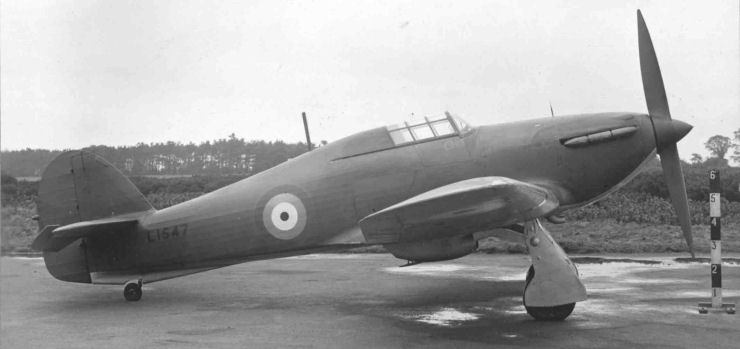

Hawker Monoplane, F.36/34 K-5083
Merlin C
| At Full Throttle | |||||||||||||||||||||||||||||||
| Height Feet | Speed M.P.H | Time to Climb Mins | Rate of Climb ft/min | ||||||||||||||||||||||||||||
| S.L | 253 | 0 | 2550
| 2000 | 261.5 | 0.75 | 2650
| 5000 | 274 | 1.89 | 2810
| 10000 | 295.5 | 3.63 | 2680
| 15000 | 314 | 5.70 | 2150
| 20000 | 311 | 8.40 | 1620
| 25000 | 301.5 | 12.08 | 1100
| 30000 | 282.5 | 18.10 | 570
| |
Hurricane L.1547
Trials with 2-pitch metal aircsrew
| Height in Standard Atmosphere Feet | True Air Speed M.P.H. | A.S.I. M.P.H. | Compressibility and Position Error Correction | R.P.M. | Boost lb./sq. in. | Remarks | |
| Sea Level | Eight guns with flash eliminators fitted. Coolant flap in position for minimum drag. | ||||||
| 1,000 | |||||||
| 2,000 | |||||||
| 3,000 | |||||||
| 5,000 | |||||||
| 6,500 | |||||||
| 10,000 | 296 | 266 | -1.7 | -10.0 | 2775 | +6.25 | |
| 13,000 | 305.5 | 262 | -2.3 | -9.9 | 2850 | +6.25 | |
| 15,000 | 312 | 260 | -2.7 | -9.9 | 2900 | +6.25 | |
| 16,500 | 317 | 258.5 | -3.0 | -9.8 | 2940 | +6.25 | |
| 18,000 | 319.6 | 254 | -3.2 | -9.8 | 2960 | +5.8 | |
| 20,000 | 318 | 245 | -3.4 | -9.6 | 2935 | +4.0 | |
| 23,000 | 312.5 | 229 | -3.5 | -9.5 | 2880 | +2.0 | |
| 26,000 | |||||||
| 17,500* | 320 | 257 | -3.2 | -9.8 | 2965 | +6.25 | |
Hurricane L.2026
(Merlin III)
(Rotol Constant Speed Airscrew)
Comparitive Performance Trials
under
Normal and Overload conditions
| At Full Throttle | |||||||||||||||||||||||||||||||
| Height Feet | Speed M.P.H | Time to Climb Mins | Rate of Climb ft/min | ||||||||||||||||||||||||||||
| S.L | 0 | 0
| 2000 | | 0.75 | 2610
| 5000 | 276 | 1.9 | 2625
| 10000 | 291 | 3.8 | 2640
| 15000 | 307 | 5.85 | 2250
| 20000 | 316 | 8.35 | 1675
| 25000 | 307 | 12.0 | 1100
| 30000 | 292 | 18.3 | 530
| | |
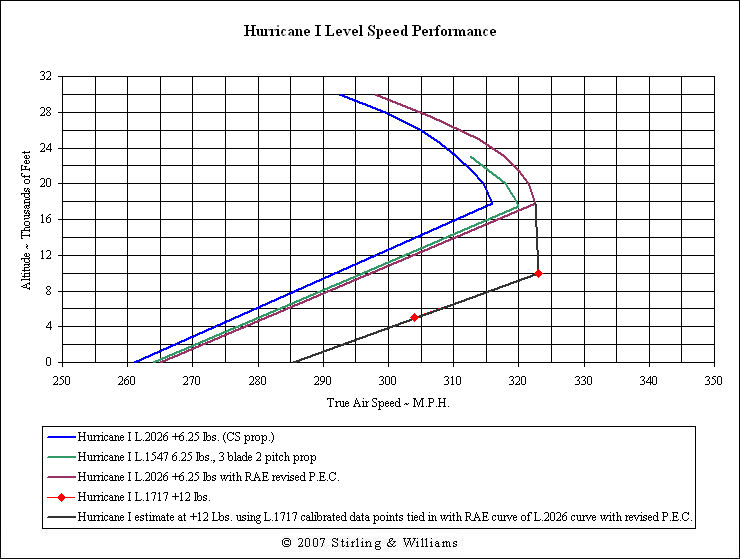
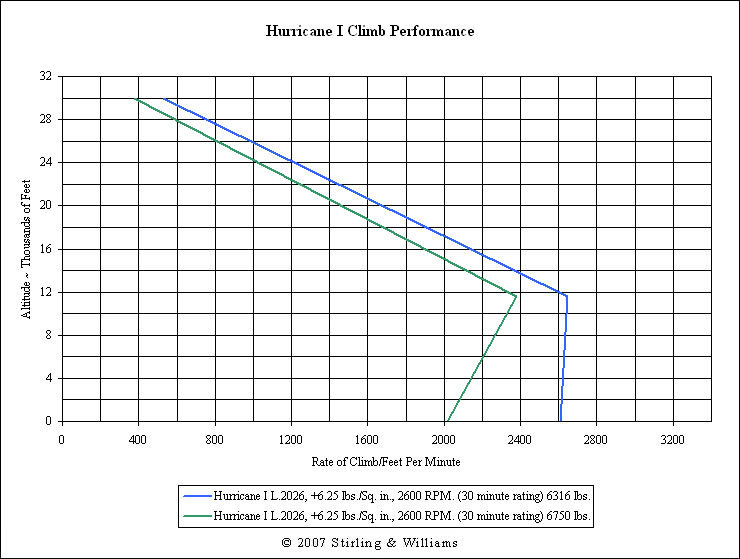
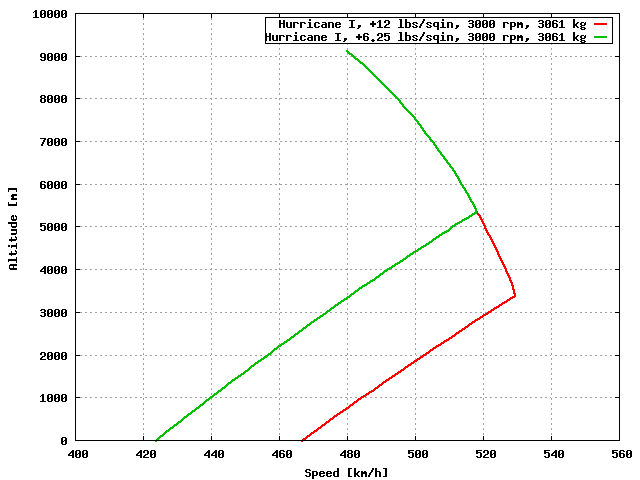
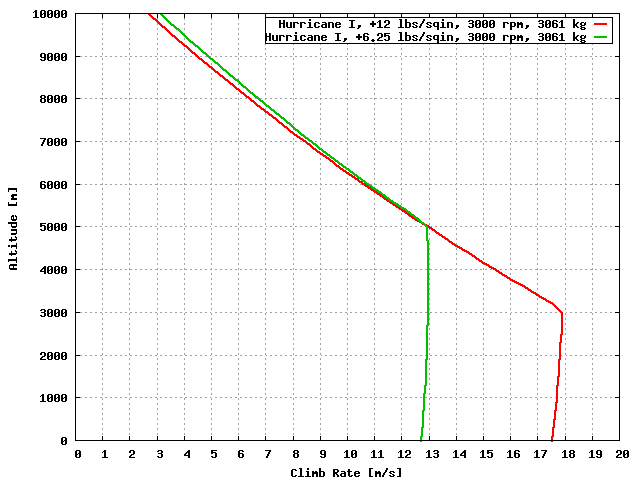
| Handling of Merlin in Hurricane, Spitfire and Defiant Aircraft, H.C.T. Dowding, C-in-C Fighter Command, 1 August 1940: |

|
| 56 Squadron Combat Report noting +12 boost for Hurricanes, 9 May 1940 | ||||||||||||||||||||||||||||||||||||||||||||||
| S/L J.O.W. Oliver, 85 Squadron, 10 May 1940 "... I pulled the plug." | ||||||||||||||||||||||||||||||||||||||||||||||
| F/O Paul Richey, 1 Squadron, 11 May 1940 "...boost-override pulled." Paul Richey DFC, Fighter Pilot (Redwood Press, Wiltshire 1990) p 76. (first published in Great Britain by B.T. Batsford Ltd., 1941.) | ||||||||||||||||||||||||||||||||||||||||||||||
| F/O E. J. Kain, 73 Squadron, 14 May 1940 "...pulling his boost cut out..." Noel Monks, Fighter Squadrons, (Angus and Robertson, Sydney : London, 1941), p 98-99 (See also Cull, Twelve Days in May), pg 124. | ||||||||||||||||||||||||||||||||||||||||||||||
| P/O D. W. A. Stones, 79 Squadron, 14 May 1940 " I now pulled out the emergency boost-plug for the first time ever..." Donald Stone, Dimsie, (Wingham Press, Canterbury, 1991), p 32. | ||||||||||||||||||||||||||||||||||||||||||||||
Sgt. R. C. Winlkinson, 3 Squadron, 14 May 1940 "12 P.S.I."
Kenneth James Nelson, C.D., Spitfire RCD, The Wartime Exploits of Royce Clifford Wilkinson O.B.E, D.F.M. & Bar, Hignall Printing Ltd., Canada, 1994). p. 6.
| P/O R. P. Beamont, 87 Squadron, 15 May 1940 "I pulled the tit'* for over-boost... *Emergency boost over-ride on the Merlin engine."
Roland Beamont, My Part of the Sky, (Patrick Stephens Limited, Wellingborough, Northamptonshire), pg 30.
| S/L E. M. Donaldon, 151 Sqdn., Combat Report, 18 May 1940 "I pulled the plug and climbed at 10 lbs boost…"
| P/O John Bushell, 151 Sqdn., Combat Report, 18 May 1940 "I used full 12 lb boost (pulled the plug) and overtook EA rapidly."
| (Note: these 18 May 1940 combats of 151 Squadron occurred while operating from Vitry, France.) P/O F. B. Sutton, 56 Squadron, 18 May 1940 Vitry, France: "...I had to pull the tit... Emergency boost control giving extra power"
Barry Sutton, The Way of a Pilot, (MacMillan & Co, Ltd., London 1943) pp. 79-80
| F/O C. F. G. Adye, 17 Squadron, 18 May 1940 "...pulled emergency boost control..."
| F/Lt I. R. Gleed, 87 Squadron, 18 May 1940 "At about 100 feet I straighten up, pull the tit *; a jerk as my supercharger goes up to twelve boosts."
W/C Ian Gleed D.F.C., Arise to Conquer, (Random House, New York 1942) p. 49.
| F/Lt I. R. Gleed, 87 Squadron, 19 May 1940 "Here goes with the tit. A jerk - the boost's shot up to twelve pounds; speed's increased by 30 m.p.h."
Ibid p. 61.
| F/O C. F. G. Adye, 17 Squadron, 19 May 1940 "...pulled emergency boost..."
| Sgt. L.H.B. Pearce, 79 Squadron, 20 May 1940 "Pulled tit..."
| Sgt. J. C. Harrison, 229 Squadron, 28 May 1940 "I pulled the emergency boost and followed him down still firing."
| P/O K. B. McGlashan, 245 Squadron, 28 May 1940 "We’d boost an extra four pounds, from eight to twelve…"
| S/L Kenneth Butterworth McGlashan with Owen Zupp, Down to Earth, (Grubb Street, London, 2007), pg 29. P/O C. M. Simpson, 229 Squadron, 29 May 1940 "...I followed it down with boost out and pulled."
| Sgt. P. Ottewill, 43 Squadron, 1 June 1940 "...automatic boost cut-out pulled."
| F/Lt. R. G. Dutton, 145 Squadron, 1 July 1940...pulled the plug..."
| P/O G. Page, 56 Squadron, July 1940 "Pulling the "Tit"*... *An emergency knob for supplying additional power to the engine."
Geoffrey Page DSO, OBE, DFC and Bar, Shot Down in Flames, (Grub Streeet, London, 1999), pg. 58.
| P/O G. E. Goodman, 1 Squadron, 18 August 1940 "...I pulled the plug..."
| P/O Wicks, 56 Squadron, 30 August 1940 "With full throttle & emergency boost..."
| P/O J. R. B. Meaker, 249 Squadron, 6 September 1940 "...so I pull the plug..."
Brian Cull, 249 at War, (Grub Street, London 1997) p. 17.
| F/Lt J. A. Kent, 303 Squadron, 9 September 1940 "...I pulled the boost override plug..."
Group Captain J. A. Kent, One of the Few, (Corgi, London 1975) p. 108.
| P/O T. F. Neil, 249 Squadron, 18 September 1940 "Plug pulled..."
Wing Commander Tom Neil, DFC, AFC, AE, Gun Button to 'Fire', (William Kimber, London 1987), pg 115.
| P/O R. G. A. Barclay, 249 Squadron, 27 September 1940 "I had to use automatic boost cutout to catch up the 109."
| P/O K. W. MacKenzie, 501 Squadron, 5 October 1940 "With the tit pulled for absolute full power..."
| S/L A. A. McKellar, 605 Squadron, 7 October 1940 "I followed one, pulled my boost control, and speedily made up on him."
| Sgt. G. A. Stroud, 249 Squadron, 29 October 1940 "I chased one pair which I overhauled with use of boost..."
| Conversion of Hurricane Aircraft D.H. Two-Pitch Airscrews to Constant Speed.
| F/Lt I. R. Gleed, 87 Squadron, 19 May 1940 Rotol constant-speed airscrew used in France.
W/C Ian Gleed D.F.C., Arise to Conquer, (Random House, New York 1942) pp. 62-63.
| 1 Sqdn. Operations Record Book, 18 April 1940: "A new Hurricane was delivered to the Squadron, equipped with a constant speed airscrew and was flown by the C.O. and other pilots, all of whom were greatly pleased with it's superior performance.
| 
1 Sqdn. Operations Record Book, 2 May 1940: "Five machines flew to Amiens and four were exchanged for the new constant speed airscrew Hurricanes."
| 
F/O Paul Richey, 1 Squadron, 15 May 1940 France: "I was flying a new aeroplane with a Rotol constant-speed prop..."
Paul Richey DFC, Fighter Pilot (Redwood Press, Wiltshire 1990) p 93.
| 151 Sqdn. Operations Record Book, 14 April 1940: "Hurricane R3310 with Rotol Airscrew flown from No. 20 M.U. at Aston Down by F/O. Newton."
| 151 Sqdn. Operations Record Book, 15 May 1940: "The squadron can now put up 12 Rotol Hurricanes if required."
|  32 Squadron, 19 May 1940: "No. 32 (F) Squadron, based at Biggin Hill and flying Hurricanes with Rotol propellers, went into action on 19th May over Cambrai…"
Francis K. Mason, The Hawker Hurricane, (Doubleday, New York 1962) p 48.
| 229 Squadron Operations Record Book, 23 May 1940: "Rotol Hurricane"
| 213 Squadron Operations Record Book, 25 May 1940: "Rotol Airscrews"
| 79 Squadron Operations Record Book, 9 June 1940: "Rotol airscrew"
| 242 Squadron, June 1940: "Rotol constant speed propellers had been fitted to the Hurricanes in early June, replacing the two-position propellers of earlier models."
Hugh Halliday, No. 242 Squadron, The Canadian Years, (Canada's Wings, Ontario, 1981). p.78.
| P/O T. F. Neil, 249 Squadron, June 1940: "It had a constant-speed Rotol propeller..."
Wing Commander Tom Neil, DFC, AFC, AE, Gun Button to 'Fire', (William Kimber, London 1987), pg 48.
| June 1940 - one of 249's first Hurricanes, with metal wings and Rotol airscrew
| The Latest Rotol Airscrew, Flight, May 23,1940
| 17 Sqdn. Operations Record Book, 5 October 1939: "bullet-proof section in the windscreen."
| 1 Sqdn. Operations Record Book, 12 March 1940: "All aircraft in squadron have been fitted with rear armour."
| 145 Sqdn. Operations Record Book, 18 May 1940: "armour plated aircaft"
| 151 Sqdn. Operations Record Book, 11 May 1940: "Rear Armour plating has now been fitted to all the Hurricanes at present held by the squadron."
| |